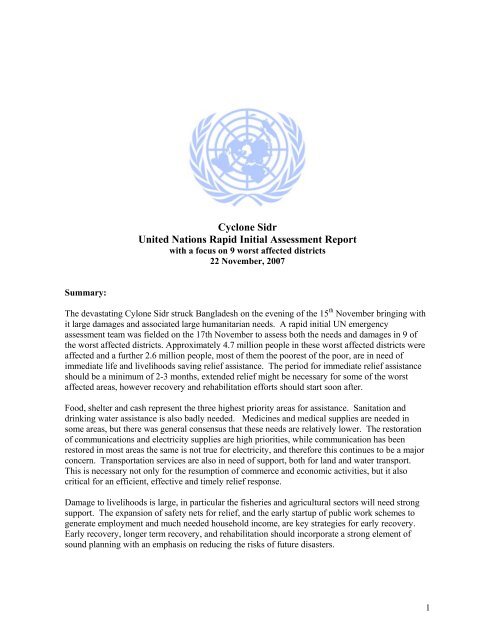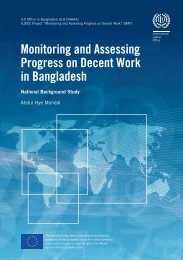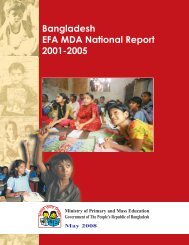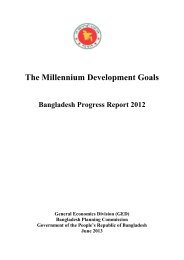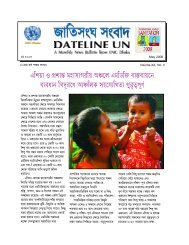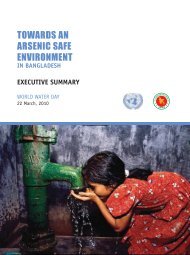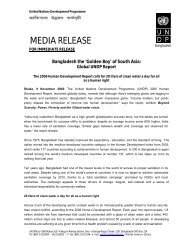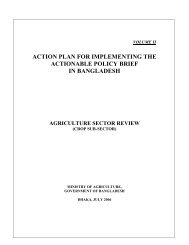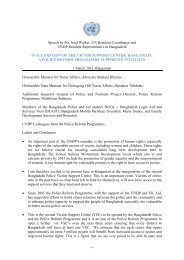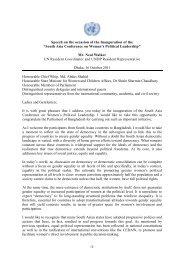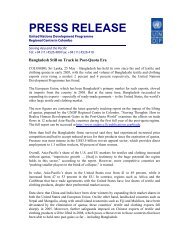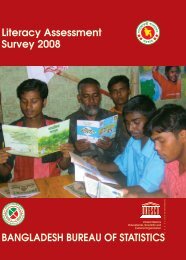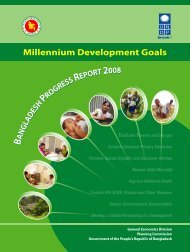Cyclone Sidr United Nations Rapid Initial Assessment Report
Cyclone Sidr United Nations Rapid Initial Assessment Report
Cyclone Sidr United Nations Rapid Initial Assessment Report
Create successful ePaper yourself
Turn your PDF publications into a flip-book with our unique Google optimized e-Paper software.
<strong>Cyclone</strong> <strong>Sidr</strong><strong>United</strong> <strong>Nations</strong> <strong>Rapid</strong> <strong>Initial</strong> <strong>Assessment</strong> <strong>Report</strong>with a focus on 9 worst affected districts22 November, 2007Summary:The devastating Cylone <strong>Sidr</strong> struck Bangladesh on the evening of the 15 th November bringing withit large damages and associated large humanitarian needs. A rapid initial UN emergencyassessment team was fielded on the 17th November to assess both the needs and damages in 9 ofthe worst affected districts. Approximately 4.7 million people in these worst affected districts wereaffected and a further 2.6 million people, most of them the poorest of the poor, are in need ofimmediate life and livelihoods saving relief assistance. The period for immediate relief assistanceshould be a minimum of 2-3 months, extended relief might be necessary for some of the worstaffected areas, however recovery and rehabilitation efforts should start soon after.Food, shelter and cash represent the three highest priority areas for assistance. Sanitation anddrinking water assistance is also badly needed. Medicines and medical supplies are needed insome areas, but there was general consensus that these needs are relatively lower. The restorationof communications and electricity supplies are high priorities, while communication has beenrestored in most areas the same is not true for electricity, and therefore this continues to be a majorconcern. Transportation services are also in need of support, both for land and water transport.This is necessary not only for the resumption of commerce and economic activities, but it alsocritical for an efficient, effective and timely relief response.Damage to livelihoods is large, in particular the fisheries and agricultural sectors will need strongsupport. The expansion of safety nets for relief, and the early startup of public work schemes togenerate employment and much needed household income, are key strategies for early recovery.Early recovery, longer term recovery, and rehabilitation should incorporate a strong element ofsound planning with an emphasis on reducing the risks of future disasters.1
Damage assessment:Food SecurityMore than 1.6 million acres of cropland is reportedly damaged. The main crop damaged is rice,currently under cultivation during this Aman season. Unlike many other regions in Bangladesh, thearea affected has a single harvest during the months of November thru January. Thus the timing ofthe cyclone was particularly harmful, in that many of the crops were at or nearly ready for harvest.A quarter of ready-to-harvest crops have been destroyed. Many households lost their food stocks asa result of severe damage to housing.Large numbers of cattle, buffalos, goats and poultry have been killed. The GoB estimates thatnearly 382,000 livestock animals were killed; the large majority of these are believed to be cattle.<strong>Assessment</strong> team members witnessed many animal carcasses floating in the rivers or washed up onthe river banks. Livestock losses represent not only a loss of critical household assets, with anassociated loss to wealth and income, but also a loss in milk production for own consumption.In coastal areas fish are a key source of food and animal protein. During the near term period fishconsumption in the diet is likely to decline, as catches are reduced due to either damage to boatsand nets etc., and/or the unavailability of labor which is diverted to other critical activities such ashousing repairs and reconstruction. Fish production from household ponds and shrimp fisheries isalso likely to decline, as many ponds and shrimp cultivation areas were badly damaged and litteredwith storm wreckage and debris.Food markets in the affected areas are generally functional. However, many small shops sellingfood in worst affected areas were severely damaged due to strong winds and falling trees. Foodprices were already high prior to the storm due to high international food prices and earlier floodrelated losses, prices are expected to stay high for the near to medium term. Physical access to foodmarkets has been disrupted in some of the worst affected areas, however most of the trees blockingroads and thereby hindering the transport of food to market areas have been cleared, and so foodavailability in the markets in not a major concern.Where housing damages are particularly bad, household kitchens and cooking areas have beenbadly affected, with serious implications for the ability to cook and utilize food. Although theaffected population was able to salvage some possessions, many people are unable to cook due tomissing utensils.Shelter and Non-Food Items:Housing damages represent the most visible and tangible damages associated with this disaster. Forworst affected areas assessment team members witnessed numerous cases of flattened, overturnedor sideways leaning household structures. Piles of damaged housing and construction materialswere common within the hardest hit residential areas, as families and communities began cleaningup the aftermath of the storm.The total number of houses damaged is nearly 1.2 million according to GoB sources, approximately30% of these are reported as fully damaged, and the remaining 70% partially damaged.3
Education:More than 8,000 educational institutions have been damaged according to the latest available GoBsitrep. Large quantities of educational materials, including books and furniture, have beendestroyed. It was not uncommon for assessment teams to witness flattened or badly damagedschool buildings, in some of the worst affected areas. Schools that remain open are reportedlyexperiencing extremely low attendance.Livelihoods:Income generation has been severely affected in all sectors. The fisheries and agricultural sectorsare worst-affected. Destruction of fisheries and crops will seriously affect income generation in themonths to come. Secondary sectors, including van and rickshaw pullers, market traders and daylabourers, are also badly affected. The forestry sector (community, government and private) hassuffered major losses, primarily because of the large number of trees uprooted.The map on the following page highlights the cyclone path, worst affected districts, lesser affectedareas, and also districts assessed by the UN teams.5
Needs:Needs GeneralThe humanitarian needs resulting from the <strong>Cyclone</strong>’s destruction are large, and immediate lifesaving relief assistance is urgently needed. This rapid initial assessment confirmed that needs aregreatest in three primary areas; food, shelter, and cash for livelihoods support. Support for thewater and sanitation sectors are also needed, however needs are lesser in these areas. Health andmedical needs are relatively low, although this varies geographically. Of the estimated 4.7 millionpeople affected in the 9 assessed districts, more than half, or 2.6 million people were deemed to bein need of immediate life saving relief assistance for a period of 2 to 3 months. Children andwomen are generally more affected then men. Children are over represented in numbers of deaths,due to their lack of physical strength many were unable to withstand the winds and tidal surgesassociated with the storm.Food SecurityApproximately 2.2 million are in need of food assistance, both in terms of dry food (first 1-2weeks), then rice, and finally a more complete food aid basket with pulses and cooking oil for a 2-3month period. Food markets in the affected areas are generally functional. However, many smallshops selling food in the worst affected areas collapsed or were severely damaged due to the strongwinds and falling trees associated with the storm.Dry food assistance (i.e. ready to eat food) is particularly important in many areas for theimmediate term, as housing and cooking areas are gradually repaired.Shelter and Non-Food ItemsApproximately 1.4 million people are in need of urgent shelter assistance. Shelter materials such ascorrugated iron sheets, wood, and other construction materials are badly needed. Many houseswere completely destroyed and an even larger number were partially damaged. Despite the factthat assessment teams witnessed many communities and households already engaging in self helpshelter reconstruction and repair, it is very clear that external assistance to this sector is desperatelyneeded as many of the poor simply do not have the economic means to engage in these types of selfhelp activities.Non food items such as clothing and blankets are also needed. Approximately 1.2 million peopleare in need of clothing.Water and SanitationSanitation needs are significant, considering the large number of houses destroyed or damagedthere is a corresponding need for family latrines. An estimated 1.3 million people are in need ofurgent sanitation assistance.Drinking water is needed in some areas however in general local government authorities andcommunity members did not highlight drinking water as a major need for all worst affected areas.7
Nevertheless, an estimated 1.2 million people are in need of immediate drinking water supplies andso these needs are indeed substantial.HealthMedicine and medical supplies are a lesser priority for most of the worst affected areas. Anestimated 523,000 people are in need of medicine, or medical supplies and services. Although thestorm resulted in a loss of electricity in many places, most hospitals and clinics were able to keepvaccines cold through the use of generators, cold boxes, and other means. The pre-positioning ofessential drugs and medicines including water purification tablets (WPT) was a major advantage interms of preparedness and response.LivelihoodsLivelihoods most affected include fishing communities, farmers, and small traders. Consideringthe concentration of the cyclone in coastal areas, many fishermen died, boats, nets, and otherrelated equipment have been damaged. Many small farmers were also badly affected, althoughdamage to crops was not extensive. Nonetheless, some fields were clearly badly flattened by thestrong winds and significant support will be needed to help agricultural livelihoods. Manylivestock died, and assessment teams witnessed many animal carcasses floating in the rivers orwashed up on the river banks. Loss of animals represents a critical asset loss for rural communitiesand cash assistance for the purchase of animals should be considered. Cash assistance is alsoneeded to procure housing materials, for purchase of food on the market, for other essentials suchas drugs and medicines, and more generally to support livelihoods.The table below gives summary statistics for 6 worst affected districts covered by the UN<strong>Assessment</strong> teams. Needs for a further three districts are also included, these areas weresimultaneously assessed by WFP assessment teams working out of the WFP Jessore sub-officeapplying the same assessment methodology.Number ofDistrict PeopleNumber People in Need of Immediate Relief Assistance ( 9 Priority Districts )Affected Total Food Shelter Water Sanitation Clothing MedicineBarisal 1,155,325 704,000 407,500 456,000 184,100 290,600 224,900 122,000Bhola 160,000 80,000 80,000 80,000 80,000 60,000 60,000 40,000Patuakhali 935,187 522,440 397,434 241,046 47,100 203,736 187,450 0Borguna 514,556 222,605 361,905 113,742 234,600 133,027 164,442 0Jhalokathi 517,900 413,120 325,250 329,050 174,375 312,840 290,700 89,924Pirojpur 932,159 299,181 269,263 71,434 217,000 0 20,747 0Bagherat 345,000 250,500 250,500 84,327 201,600 201,600 201,600 201,600Khulna 94,000 54,075 54,075 54,075 54,075 54,075 54,075 54,075Satkhira 47,500 15,000 15,000 15,000 15,000 15,000 15,000 15,000Total 4,701,627 2,560,921 2,160,927 1,444,674 1,207,850 1,270,878 1,218,914 522,599What about the remaining 21 affected districts?GoB sources note that an additional 21 districts are known to be affected by the cyclone. There isgeneral consensus that damages and related needs in these 21 districts are much lower relative tothe 9 UN assessed districts. The government of Bangladesh is gathering damage related data forthese additional areas, from which it might later be possible to get a better understanding of total8
national cyclone related needs. According to the latest GoB MoFDM Situation report, as of 21 stNovember the total number of affected people for 30 districts was 6,737,815.Recommendations:• Immediate life saving relief food assistance should be provided for 2,161,000 people inthe 9 worst affected districts. Dry food such as high energy biscuits, flattened rice andmolasses are appropriate for the near term (1-2 weeks) considering the loss of cookingfacilities and cooking utensils for many of the worst affected households. Food items suchas rice should also be immediately distributed as soon as possible. A more complete foodaid basket including pulses and oil are appropriate for the mid to end period of the 2-3month relief distribution period.• Shelter assistance is urgently needed. Materials for housing reconstruction andrepairs such as corrugated iron sheets, wood, poles, nails, hammers, saws, etc… arehigh priority items for shelter assistance. It will be important to incorporate sounddisaster risk reduction elements into the rebuilding efforts. Many of the worst damagedhouses were located in very close proximity to shorelines and in open wind exposed areas,thus rebuilding in these areas will only contribute to continued future vulnerability.• Sanitation assistance is needed for many of the worst affected areas. Physical damageto household latrines was fairly common. In many cases where roofs or entire walls werelost there is now a complete absence of privacy. The rebuilding of houses and associatedlatrines further away from shorelines and surface water bodies such as ponds, will benefitfuture disaster risk reduction particularly in terms of preventing water contamination andwater born diseases.• Immediate drinking water supplies are needed for an estimated 1.2 million people. Insome of the worst affected areas, water wells were contaminated with saline water. Wherepiped water exists, the lack of electricity or its erratic supply present major challenges interms of access to safe drinking water.• Medical facilities are in need of quick repair and the restoration of electricity, insupport of medical services is particularly important. Approximately 523,000 people inthe worst affected districts are in need of urgent medicine, medical supplies, or supportingmedical services.• Sufficient human and material resources must be dedicated to the coordination ofrelief operations. A well coordinated, efficient, effective, and timely response willcontinue to be a major challenge. Coordination between national institutions such asMinistries, the military, customs, etc. are critical. Effective national to internationalcoordination also presents a challenge. The number of international institutions eitherproviding funding, operational support, or directly implementing relief assistance is rapidlygrowing, as aid from around the world flows into Bangladesh. Coordination on logisticsand information management represent two of the highest priority coordination areas.• The reconstruction or repair of roads, embankments, and culverts is a high priority. Itis not too early to be thinking about the planning and implementation of early recovery, orlonger term recovery and rehabilitation efforts for specific critical community assets andinfrastructure. Since these efforts require considerably longer implementation periods, they9
End.should be planned and implemented on a timeline that allows early completion well inadvance of the 2008 monsoon season. The implementation of early public work schemesand safety nets either using cash for work or food for work is critical. The beneficialeffects of generating employment and much needed income for worst affected poor peoplecannot be underestimated.• Risk analysis and risk mitigation should be a mandatory element of any newconstruction or replacement programme design. This should involve both single sectorand cross sector risk analysis.• Contingency planning and capacity building is required at the field level to strengthenearly warning, evacuation, rescue, relief management, damage assessment capabilities andinteragency coordination.• Community Disaster Learning Centers should be established and risk reductionmeasures should be undertaken in severely affected and highly vulnerable districts.• Follow on more in-depth assessments are required, for a more accurate understandingof needs and programming options.10
Annex-1: Response to dateResponse to dateThe Government of Bangladesh’s early warning and preparedness systems were activated prior tothe cyclone making landfall, which greatly reduced the humanitarian impact of this disaster.Preparedness measures included the evacuation of approximately 3.2 million people and theopening of more than 2,000 cyclone shelters. More than 42,000 volunteers were engaged to helppeople in affected areas find suitable shelter.National responseTo date the Chief Adviser has allocated 100 million taka for relief and house construction in 11Districts. The Ministry of Food and Disaster Management (MoFDM) has allocated 4,000 MT ofrice, 7,500 tents, 18,000 blankets and 30 million taka in relief grants to date. A special fund hasbeen established allocating 350 million taka for housing construction. 13,000 bundles of corrugatediron sheets and family kit packages (cloths, utensils, jerry can, candles, plate, mug etc) includingfood items (lentils, salt, sugar, oil etc) have been prepared for immediate distribution. 732 medicalteams are now working in the affected areas. The Bangladesh Armed Forces Division has deployedseveral aircraft and a number of helicopters. Six Bangladesh Navy ships are now conductingrescue, evacuation, relief and reconnaissance operations in cyclone affected areas. In areasinaccessible by road the military continues to deliver relief items with aircraft, helicopters andboats.International responseThe UN, IFRC and NGOs including Save the Children, World Vision International, CARE, Caritas,OXFAM, Islamic Relief, ACT, Adventist Development and Relief Agency (ADRA), Muslim Aid,CONCERN, Plan and ActionAid continue to provide support to the Government of Bangladeshthrough extensive emergency response mechanisms, including mobilizing in-country staff and prepositionedrelief stocks across southern Bangladesh.WFP initiated an immediate response with the distribution of 98 MT of high energy biscuits tomore than 650,000 people through NGO implementing partners. Distribution of 184 MT is ongoingand a further 200 MT is in the pipeline.UNICEF is currently procuring 60,000 family kits, 100,000 jerry cans, 92 MT of baby food,100,000 blankets, 60,000 family kits, 60,000 clothing items for children, 50,000 plastic sheets, tubewells and essential medicines.The UN Resident Coordinator (RC) and UN Heads of Agencies visited a number of affecteddistricts on 19 November. Severe material damage was noted, with some variation betweenregions. The team confirmed that relief is reaching the furthest corners of the affected area, withindications of small-scale economic recovery.The UN Emergency Relief Coordinator (ERC) released an initial allocation of USD 8.75 millionfrom the Central Emergency Relief Fund (CERF) for Agriculture, Child Protection, Food, Nutritionand Water and Sanitation projects on 21 November. A second round of allocations is beingconsidered to address Heath and Shelter needs.i
IFRC launched a preliminary emergency appeal on 16 November for USD 3.5 million to supportthe Bangladesh Red Crescent Society to assist 235,000 beneficiaries for a period of 9 months.Media reports indicate that the government of Saudi Arabia has pledged $USD 100 million andadditional relief items for cyclone victims.The World Bank announced $USD 250 million for budgetary support and relief. Some of thesefunds could be diverted from existing programmes.The following countries have pledged assistance to the relief effort so far: Australia (USD 2.7million); Czech Republic (USD 81,000); Estonia (USD 46,000); France (USD 730,000); Germany(USD 1 million); India (USD 1 million); Ireland (USD 720,461); Spain (USD 1 million); <strong>United</strong>Kingdom (USD 5.2 million); <strong>United</strong> States of America (USD 5 million). The USA also contributedUSD 100,000 in initial emergency assistance. The European Commission Humanitarian Aid Office(ECHO) has pledged USD 9.2 million.Financial ContributionsFor updated information on financial contributions, please refer to the OCHA Financial TrackingSystem website: http://ocha.unog.ch/fts2/. Donors are encouraged to verify this table and informFTS of corrections/additions/values to this table.AustraliaDonorRecipientorganizationNGOs (details notyet provided)USDcommitted/contributedUSDpledgedDescription0 917431 Provision of safe water and sanitation facilities,supplementary feeding for women and children, and non fooditems including clothes and blankets0 917431 To meet immediate food needs and support recoveryprograms0 917431 To support the Bangladesh Red Crescent Societies reliefefforts, including basic health care and emergency sanitation.AustraliaWorld FoodProgrammeAustraliaInternationalFederation of RedCross and RedCrescent SocietiesCanadaInternational261780 0 To meet the basic needs of the communities affectedFederation of RedCross and RedCrescent SocietiesCanadaUN Agencies,0 3141361 To provide relief to the communities in needNGOs and RedCross (details notyet provided)Caritas Spain Caritas Spain 288184 0 Emergency aid to affected populationCentral Emergency <strong>United</strong> <strong>Nations</strong>556400 0 CERF rapid response grant to project: Meeting the emergencyResponse Fund Children's Fundneeds in water supply, sanitation and hygiene for theCentral EmergencyResponse FundCentral EmergencyResponse FundCentral EmergencyResponse FundCentral EmergencyResponse FundCentral EmergencyResponse Fund<strong>United</strong> <strong>Nations</strong>Children's FundWorld FoodProgramme<strong>United</strong> <strong>Nations</strong>Children's Fund<strong>United</strong> <strong>Nations</strong>Children's FundFood & AgricultureOrganisationpopulation most-affected by the cyclone <strong>Sidr</strong>1583600 0 CERF rapid response grant to project: Essential non-fooditems support to vulnerable children and women5029000 0 CERF rapid response grant to project: <strong>Rapid</strong> EmergencyResponse to <strong>Cyclone</strong> affected people535000 0 CERF rapid response grant to project: Nutritionalsupplementation of children and women50290 0 CERF rapid response grant to project: Creating a protectiveenvironment for children in the six most cyclone affectedDistricts1000000 0 CERF rapid response grant to project:Emergency agriculturalresponse to cyclone-affected farmers and fishing communitiesChina Chinese Red Cross 0 1000000 Emergency assistance (relief and rehabilitation in thecyclone-hit areasChinese Red Cross Bangladesh RedCrescent Society0 50000 in response to appeal from Bangladesh Red Cresecent SocietyCzech RepublicInternationalCommittee of theRed Cross0 80645 Emergency aid for people in Bangladesh affected by thecyclone <strong>Sidr</strong>ii
EstoniaInternational0 46045 To provide food, clean water and medicine to the victimsFederation of RedCross and RedCrescent SocietiesECHO CARE 0 288184 Primary emergency aid to victims of cyclone <strong>Sidr</strong>(ECHO/BGD/BUD/2007/01000)ECHOIslamic ReliefWorldwide0 288184 Primary emergency aid to victims of cyclone <strong>Sidr</strong>(ECHO/BGD/BUD/2007/01000)ECHOInternationalFederation of Red0 432277 Primary emergency aid to victims of cyclone <strong>Sidr</strong>(ECHO/BGD/BUD/2007/01000)Cross and RedCrescent SocietiesECHO ActionAid 0 288184 Primary emergency aid to victims of cyclone <strong>Sidr</strong>(ECHO/BGD/BUD/2007/01000)ECHOOXFAM <strong>United</strong>Kingdom0 288184 Primary emergency aid to victims of cyclone <strong>Sidr</strong>(ECHO/BGD/BUD/2007/01000)ECHO CONCERN 0 288184 Primary emergency aid to victims of cyclone <strong>Sidr</strong>(ECHO/BGD/BUD/2007/01000)ECHO German Red Cross 0 288184 Primary emergency aid to victims of cyclone <strong>Sidr</strong>(ECHO/BGD/BUD/2007/01000)ECHOUN Agencies,NGOs and RedCross (details not0 7204611 Additional funds to meet vital needs for water, food, shelterand household items such as soap, cooking utensils andjerrycansyet provided)FranceBilateral0 432277 aide alimentaire(government togovernment)FranceBilateral(government togovernment)0 288184 aide humanitaire d´urgenceGermanyGermanyIndiaIrelandJapanKuwaitNetherlandsOPEC Fund forInternationalDevelopmentSpainSpain<strong>United</strong> KingdomNGOs (details notyet provided)World FoodProgrammeBilateral(government togovernment)UN Agencies,NGOs and RedCross (details notyet provided)Bilateral(government togovernment)Kuwait RedCrescent SocietyNetherlands RedCrossInternationalFederation of RedCross and RedCrescent SocietiesInternationalFederation of RedCross and RedCrescent SocietiesWorld FoodProgrammeUN Agencies(details not yetprovided)0 720461 To meet basic needs such as medical supplies, food anddrinking water and to provide more emergency shelters0 288184 Emergency food aid0 1000000 Comprehensive relief package of relief materials requiredurgently by those affected, including medicine, food items,milk powder, tents and blankets, first-aid kits and other reliefitems.0 720461 To help meet the immediate needs of those worst affected307018 0 Tents, blankets, sleeping mats, plastic sheeting, portablereservoirs, water purifying equipment, plastic watercontainers, and electric power generators JICA its warehousein Singapore to the Bangladeshi capital of Dhaka. (value notreported)10000000 0 In kind - emergency relief assistance to alleviate the sufferingof the affected population from the effects of the hurricaneand the floods0 1440922 Emergency goods such as food, shelter, drinking water andbasic health care500000 0 Provide essential relief supplies and support emergencyoperation for cyclone victims in Bangladesh0 360231 Provision of drinking water0 720461 Emergency food aid0 5165289 Immediate cyclone relief efforts, to help deal with the impactof <strong>Cyclone</strong> <strong>Sidr</strong>. The money is being channelled through theUN, and will help provide food, water, medical treatment,and housing repairs.<strong>United</strong> States ofAmericaBilateral(government togovernment)0 0 Deployed a five-person disaster assessment team to assistwith relief and recovery efforts in conjunction with theUSAID Mission and U.S. Embassy in Dhaka. The team isworking alongside local authorities to conduct fieldiii
<strong>United</strong> States ofAmerica<strong>United</strong> States ofAmerica<strong>United</strong> States ofAmerica<strong>United</strong> States ofAmerica<strong>United</strong> States ofAmerica<strong>United</strong> States ofAmericaBilateral(government togovernment)InternationalFederation of RedCross and RedCrescent Societiesassessments that will identify additional needs and areaswhere we might be of assistance*100000 0 <strong>Initial</strong> emergency assistance1000000 0 For water and sanitation programs and to provide sheltermaterials to those in needUSAID/Bangladesh 1000000 0 Emergency relief activities<strong>United</strong> StatesAgency forInternationalDevelopment252215 0 Emergency Relief SuppliesCARE 70000 0 Emergency relief activitiesSave the Children -USA30000 0 Emergency Relief Activitiesiv
Annex-2: PhotographsBadly damaged and leaning house located in close proximity to water.School children foreground, a flattened school building in the backdrop.v
Small shops, businesses, market areas, damaged along the road side.Facilities near a bridge and ferry crossing, badly damaged. Background shows a ferry washedashore and grounded.vi
Annex-3:Abbreviations and AcronymsBBSCDMPDCDMICDRROGoBNGOUNUNDPUNICEFUNOWFPWHOWPTBangladesh Bureau of StatisticsComprehensive Disaster Management ProgrammeDeputy CommissionerDisaster Management Information CenterDistrict Relief and Rehabilitation OfficerGovernment of BangladeshNon-Governmental Organization<strong>United</strong> <strong>Nations</strong><strong>United</strong> <strong>Nations</strong> Development Programme<strong>United</strong> <strong>Nations</strong> Children’s FundUpazilla Near-by OfficerWorld Food ProgrammeWorld Health OrganizationWater Purification Tabletsvii


